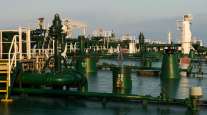Economy Keeps Growing, Even With Rising Oil Prices

DALLAS — America’s rediscovered prowess in oil production is shaking up old notions about the impact of higher crude prices on the U.S. economy.
It has long been conventional wisdom that rising oil prices hurt the economy by forcing consumers to spend more on gasoline and heating their homes, leaving less for other things.
Presumably that kind of run-up would slow the U.S. economy. Instead, the economy grew at its fastest rate in nearly four years during the April-through-June quarter.
RELATED: Diesel, Gas Prices Creep Upward
President Donald Trump appears plainly worried about rising oil prices just a few weeks before midterm elections that will decide which party controls the House and Senate.
“We protect the countries of the Middle East, they would not be safe for very long without us, and yet they continue to push for higher and higher oil prices!” Trump tweeted Sept. 20. “We will remember. The OPEC monopoly must get prices down now!”
Members of The Organization of the Petroleum Exporting Countries, who account for about one-third of global oil supplies, are scheduled to meet this weekend with nonmembers including Russia.
We protect the countries of the Middle East, they would not be safe for very long without us, and yet they continue to push for higher and higher oil prices! We will remember. The OPEC monopoly must get prices down now! — Donald J. Trump (@realDonaldTrump) September 20, 2018
The same coalition of OPEC and a few outsiders has limited production since January 2017 to bolster prices, but they agreed in June to a slight increase to offset declining output from Iran, where exports have fallen ahead of Trump’s re-imposition of sanctions.
Oil prices are up about 40% in the past year. On Sept. 21, benchmark U.S. crude was trading around $71 a barrel, and the international standard, Brent, was closing in on $80.
On Sept. 20, the national average price for gasoline stood at more than $2.84 per gallon, up 9% from a year ago, according to auto club AAA. That increase likely would be greater were it not for a slump in gasoline demand that is typical for this time of year, when summer vacations are over.
The United States still imports about 6 million barrels of oil a day on average, but that is down from more than 10 million a decade ago. In the same period, U.S. production has doubled to more than 10 million barrels a day, according to government figures.
“Because the U.S. now is producing so much more than it used to, [the rise in oil prices] is not as big an impact as it would have been 20 years ago or 10 years ago,” said Michael Maher, an energy researcher at Rice University and a former Exxon Mobil economist.
The weakening link between oil and the overall economy was seen — in reverse — just three years ago. Then, plunging oil prices were expected to boost the economy by leaving more money in consumers’ pockets, yet GDP growth slowed at the same time that lower oil prices took hold during 2015.
Other economists caution against minimizing the disruption caused by energy prices.
“Higher oil prices are unambiguously bad for the U.S. economy,” said Philip Verleger, an economist who has studied energy markets. “They force consumers to divert their income from spending on other items to spending on fuels.”
Since energy amounts to only about 3% of consumer spending, a cutback in that other 9% “causes losses for those who sell autos, restaurants, airlines, resorts and all parts of the economy,” Verleger said.
The federal Energy Information Administration said this month that the United States likely reclaimed the title of world’s biggest oil producer earlier this year by surpassing the output of Saudi Arabia in February and Russia over the summer. If the agency’s estimates are correct, it would mark the first time since 1973 that the United States has led the oil-pumping pack.
And that has made the impact of oil prices on the economy a more complicated calculation.
When oil prices tumbled starting in mid-2014, U.S. energy producers cut back on drilling. They cut thousands of jobs and they spent less on rigs, steel pipes and railcars to ship crude to refineries. That softened the bounce that economists expected to see from cheaper oil.
Now, with oil prices rising, energy companies are boosting production, creating an economic stimulus that offsets some of the blow from higher prices on consumers. Oil- and gas-related investment accounted for about 40% of the growth in business investment in the April-June quarter this year.
Moody’s Analytics estimates that every penny increase at the pump reduces consumer spending by $1 billion over a year, and gasoline has jumped 24 cents in the past year, according to AAA. That is “a clear-cut negative,” but not deeply damaging, said Ryan Sweet, director of real-time economics at Moody’s.
“Usually with gasoline prices, speed kills — a gradual increase [such as the current one] consumers can absorb that,” Sweet said. Consumers have other factors in their favor, he added, including a tight job market, wage growth, better household balance sheets and the recent tax cut.
Sweet said the boon that higher prices represent to the growing energy sector, which can invest in more wells, equipment and hiring, means that the run-up in crude has probably been “a small but net positive” for the economy.
“That could change if we get up to $3.50, $4,” he said.




